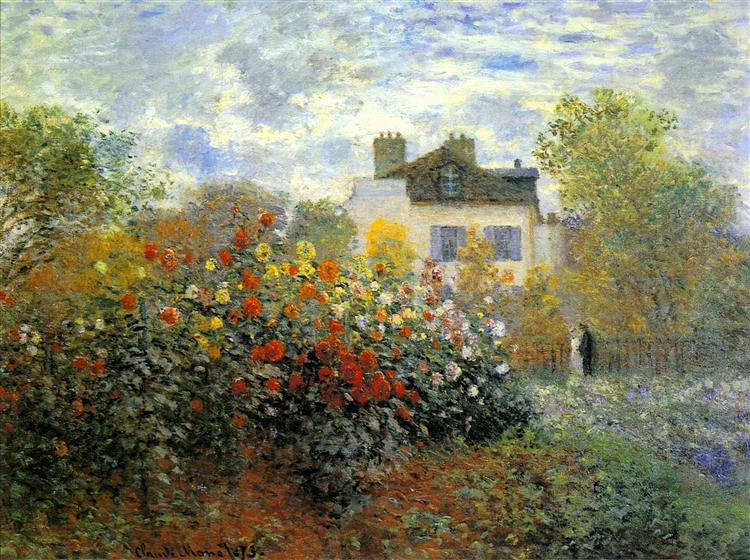Descrizione
Il dipinto "The Garden of Monet in Argenteuil" del 1873 è un'opera emblematica che incarna l'essenza dell'impressionismo e della visione artistica di Claude Monet, uno dei suoi esponenti più importanti. Questo lavoro riflette la profonda connessione che Monet ha stabilito con l'ambiente circostante, in particolare con i giardini che ha coltivato nella sua casa in ArgienteUil, dove la natura è diventata uno scenario vibrante di colore e luce. Lo spettatore viene trasportato in un angolo idilliaco, in cui i fiori brillano alla luce del sole, creando uno spettacolo visivo che, nella sua apparente semplicità, nasconde una complessità nella rappresentazione del momento.
La composizione è attentamente bilanciata attraverso una disposizione organica di fiori e arbusti, che guida lo sguardo dello spettatore verso il fondo del dipinto. La tavolozza dei colori è animata; Monet usa una vasta gamma di toni, dal giallo e verde vibrante al rosa morbido e viola, mescolando la tecnica del pennello sciolto che caratterizza l'impressionismo. Questa tecnica consente di fondare i colori tra loro, evocando l'atmosfera luminosa e mutevole di un giardino in piena estate. Le pennellate rapide e spontanee catturano non solo la luce, ma anche un senso di movimento, suggerendo che il giardino è vivo e in costante trasformazione.
In primo piano, l'esuberanza floreale diventa il focus principale e sebbene una figura umana non appaia sulla scena, il giardino può essere visto come un'estensione del Monet stesso. Gli elementi botanici sembrano prendere vita, invitando lo spettatore a immaginare la presenza di Monet che lavora tra loro, immersa nell'armonia della natura. Questa assenza di figure umane, caratteristiche in molti dipinti impressionisti, evidenzia più la connessione intima e personale tra l'artista e il suo ambiente naturale.
Un aspetto interessante di questo lavoro è il modo in cui anticipa la successiva esplorazione di Monet sul tema del giardino. Negli anni successivi, Monet ha dedicato gran parte del suo lavoro alla rappresentazione del suo giardino in Giverny, dove ha sviluppato la sua famosa serie di bisogni. "Il Giardino di Monet in Argenteuil" è quindi presentato come un lavoro di transizione che riflette non solo lo stile maturo di Monet, ma il suo desiderio di catturare la transitorie della luce e della natura, temi ricorrenti nel suo lavoro.
Questo quadro è anche testimonianza del contesto sociale e culturale del tempo; Argenteuil, vicino a Parigi, era un luogo di incontro per molti artisti impressionisti, che cercarono di sfuggire alla città e trovare ispirazione nei paesaggi vibranti circostanti. Monet, insieme ad altri contemporanei come Pierre-Auguste Renoir e Édouard Manet, usava la tecnica di pittura all'aperto Plein Air-to-to Catch Essence of Light and Color nella sua forma più pura.
In breve, "il giardino di Monet in Argenteuil" non è solo una rappresentazione visiva di un luogo specifico; È una meditazione sulla natura, la luce e l'esperienza estetica stessa. Il lavoro invita lo spettatore a immergersi nel momento perfetto che cattura la bellezza effimera, un principio fondamentale di impressionismo. In quanto tale, rimane una testimonianza duratura del talento di Monet per trasformare il quotidiano in qualcosa di straordinario, catturando la realtà non come è, ma come viene sperimentato.
KUADROS ©, una famosa vernice sul muro.
Dipinti ad olio fatti a mano, con la qualità degli artisti professionisti e il distintivo sigillo di KUADROS ©.
Servizio di riproduzione delle immagini con garanzia di soddisfazione. Se non sei completamente soddisfatto della replica del tuo dipinto, rimborsiamo i tuoi soldi al 100%.

